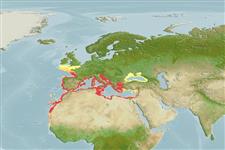Teleostei (teleosts) >
Eupercaria/misc (Various families in series Eupercaria) >
Sciaenidae (Drums or croakers)
Etymology: Sciaena: Greek, skiaina, skion = a fish, red mullet (Ref. 45335).
More on author: Linnaeus.
Environment: milieu / climate zone / depth range / distribution range
Ecology
Marine; brackish; demersal; depth range 1 - 200 m (Ref. 9505). Subtropical; 51°N - 13°N, 19°W - 42°E
Eastern Atlantic: Southern Bay of Biscay to Mauritania, occasionally southwards to Senegal. Also throughout the Mediterranean and Black seas. Records from Ghana (Ref. 6810) and Gabon (Ref. 5516) are questionable. Two records in Belgium were actually for Micropogonias undulatus (Linnaeus, 1766) (Ref. 117298). The record off Wimereux is a misinterpretation during data entry mistake from the the Müller (2004, Ref. YYY) (Bailly, pers. comm., March 2018).
Length at first maturity / Size / Weight / Age
Maturity: Lm 23.5 range ? - ? cm
Max length : 70.0 cm TL male/unsexed; (Ref. 3397); common length : 28.0 cm TL male/unsexed; (Ref. 3397); max. reported age: 21 years (Ref. 9505)
Occurs in shallow coastal waters mainly on rocky and sandy bottoms, often entering estuaries and more active at night. Also inhabits caves and reefs (Ref. 9987). Feeds on small fishes and crustaceans (Ref. 4780). SCUBA diving observations suggest this to be a very calm fish with remarkable buoyancy control and an ability to move without much apparent effort (Ref. 9505). Marketed fresh and frozen; in Turkey, otoliths are ground to a powder and used as remedy for urinary tract infections (Ref. 9987).
Chao, L.N. and E. Trewavas, 1990. Sciaenidae. p. 813-826. In J.C. Quero, J.C. Hureau, C. Karrer, A. Post and L. Saldanha (eds.) Check-list of the fishes the eastern tropical Atlantic (CLOFETA). JNICT, Lisbon; SEI, Paris; and UNESCO, Paris. Vol. 2. (Ref. 3593)
IUCN Red List Status (Ref. 130435: Version 2025-1)
Threat to humans
Harmless
Human uses
Fisheries: commercial
Tools
Special reports
Download XML
Internet sources
Estimates based on models
Preferred temperature (Ref.
123201): 12.8 - 19.6, mean 15.3 °C (based on 215 cells).
Phylogenetic diversity index (Ref.
82804): PD
50 = 0.6250 [Uniqueness, from 0.5 = low to 2.0 = high].
Bayesian length-weight: a=0.00851 (0.00773 - 0.00937), b=3.08 (3.06 - 3.10), in cm total length, based on LWR estimates for this species (Ref.
93245).
Trophic level (Ref.
69278): 3.8 ±0.5 se; based on diet studies.
Resilience (Ref.
120179): Medium, minimum population doubling time 1.4 - 4.4 years (K=0.19; tm=3; tmax=21).
Prior r = 0.59, 95% CL = 0.39 - 0.88, Based on 1 data-limited stock assessment.
Fishing Vulnerability (Ref.
59153): Moderate to high vulnerability (46 of 100).
🛈
Climate Vulnerability (Ref.
125649): High vulnerability (62 of 100).
🛈
Nutrients (Ref.
124155): Calcium = 48 [28, 95] mg/100g; Iron = 0.789 [0.426, 1.386] mg/100g; Protein = 20.1 [18.5, 21.7] %; Omega3 = 0.355 [0.207, 0.554] g/100g; Selenium = 32.5 [16.8, 59.2] μg/100g; VitaminA = 12.4 [4.3, 38.8] μg/100g; Zinc = 0.779 [0.570, 1.144] mg/100g (wet weight); based on
nutrient studies.
